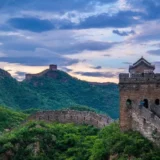The Great Wall of China: A Marvel of History and Architecture
The Great Wall of China, one of the most iconic landmarks in human history, stands as a testament to the ingenuity, determination, and architectural prowess of the ancient Chinese civilization. Stretching thousands of miles across northern China, this colossal structure has intrigued people from all over the world for centuries. In this article, we’ll delve into the fascinating history, construction, and cultural significance of the Great Wall, debunk some common myths, and explore its place in the modern world.
History of the Great Wall
The roots of the Great Wall can be traced back to the 7th century BC when various Chinese states built walls to protect their territories. However, the most well-known portions of the wall were constructed during the Qin Dynasty under the rule of Emperor Qin Shi Huang. This massive endeavor aimed to connect and reinforce these walls into a single, formidable defensive structure.
Construction and Architecture
The Great Wall showcases exceptional architectural techniques, with various sections featuring different materials and designs. From stone and brick to wood and earth, this diverse construction mirrors the unique landscapes it traverses. The wall includes watchtowers, fortresses, and gates, serving both as a physical barrier and a communication network.
Purpose and Significance
The primary purpose of the Great Wall was to defend against invasions from northern nomadic tribes. It served as a vital military asset, enabling the protection of ancient China’s fertile lands and precious resources. Beyond defense, it also facilitated trade and cultural exchange along the Silk Road.
Sections and Fortifications
The Great Wall consists of multiple sections, each with its distinct characteristics and historical significance. The most renowned segments include the Badaling, Mutianyu, and Jinshanling sections, each offering a unique experience for visitors.
The Myth of Visibility from Space
This myth has persisted for years, but in reality, the wall’s narrow width and earthy colors make it blend with the natural terrain when viewed from space.
Preservation and Restoration
Efforts have been made to preserve and restore the Great Wall, as it has faced significant deterioration over the centuries. UNESCO designated it as a World Heritage Site, highlighting the need for continued conservation.
Visiting the Great Wall
Today, the Great Wall has become a symbol of China and a global tourist attraction. Millions of visitors trek its winding paths, marvel at its breathtaking vistas, and appreciate its historical importance.
Cultural Significance
The Great Wall has woven its way into the tapestry of Chinese culture, featuring prominently in art, literature, and folklore. It is a source of national pride and a reminder of the nation’s resilience in the face of challenges.
Legends and Stories
The Great Wall is shrouded in myths and legends, some of which involve supernatural beings, while others celebrate the determination of its builders. These tales add to the wall’s mystique.
Great Wall in Popular Culture
The Great Wall has found a place in popular culture worldwide, with appearances in films, books, and art. Its enduring appeal continues to captivate the imagination of people globally.
The Great Wall Today
Despite its historical significance, the Great Wall faces modern challenges, such as urban development, tourism pressures, and environmental issues. Balancing preservation and development is a delicate task.
Challenges and Threats
The Great Wall is not immune to the passage of time and faces threats like erosion, pollution, and the impact of tourism. Ongoing efforts are crucial to ensure its longevity.
Conclusion
The Great Wall of China stands as a timeless testament to human innovation and perseverance. Its rich history, architectural marvel, and cultural significance continue to inspire awe and wonder. As we look toward the future, it is essential to balance the preservation of this iconic monument with the demands of the modern world, ensuring that future generations can continue to appreciate its magnificence.
Frequently Asked Questions (FAQs)
Is the Great Wall the only man-made structure visible from space?
No, it is not visible from space without aid.
How long is the Great Wall of China?
The total length of the wall and all its branches is over 13,000 miles.
Can I visit the Great Wall throughout the year?
Yes, but the best time to visit is during spring or autumn to avoid extreme weather.
Is the Great Wall a continuous structure?
It serves as a symbol of China’s rich history and a major tourist attraction.






